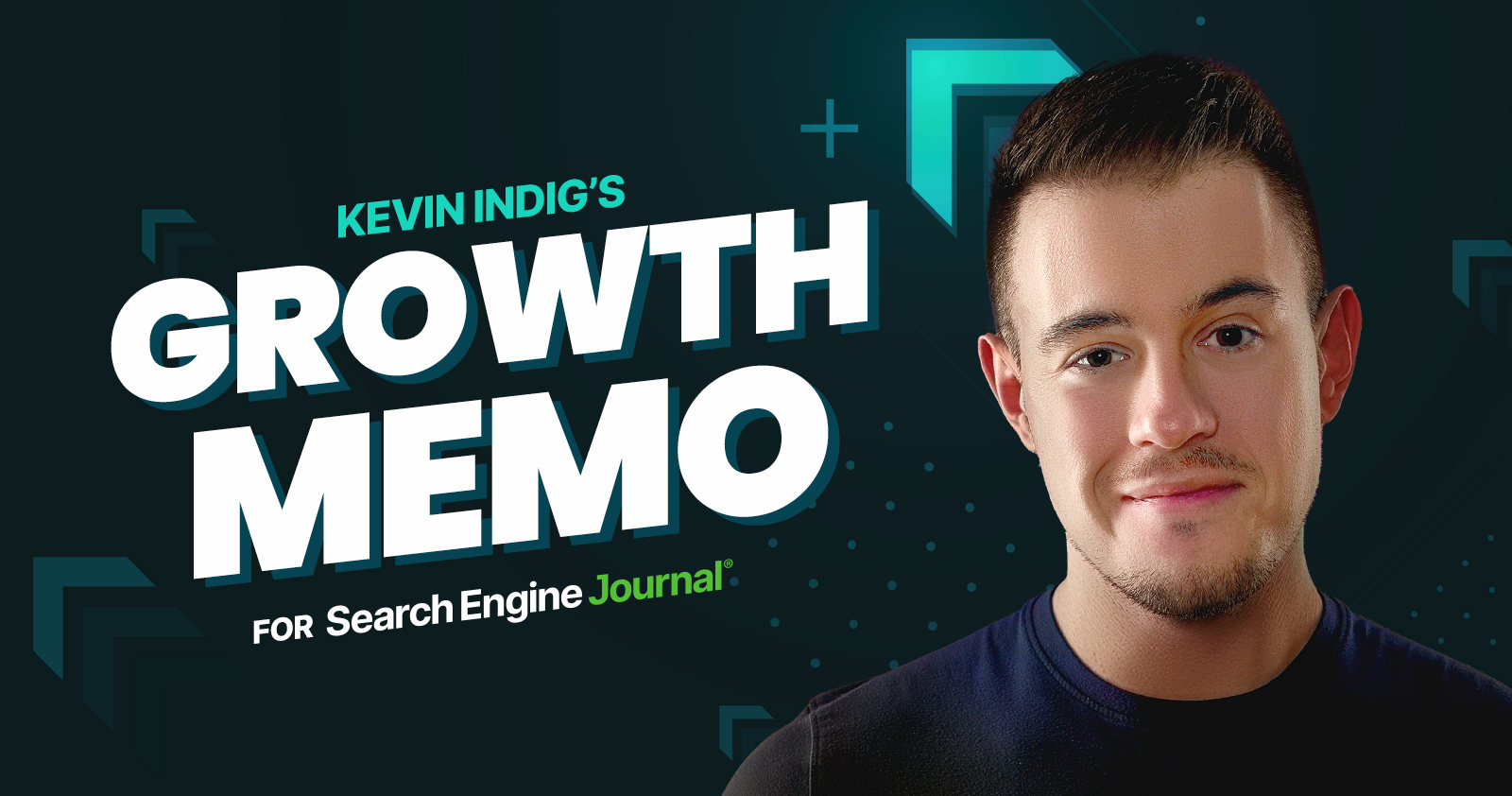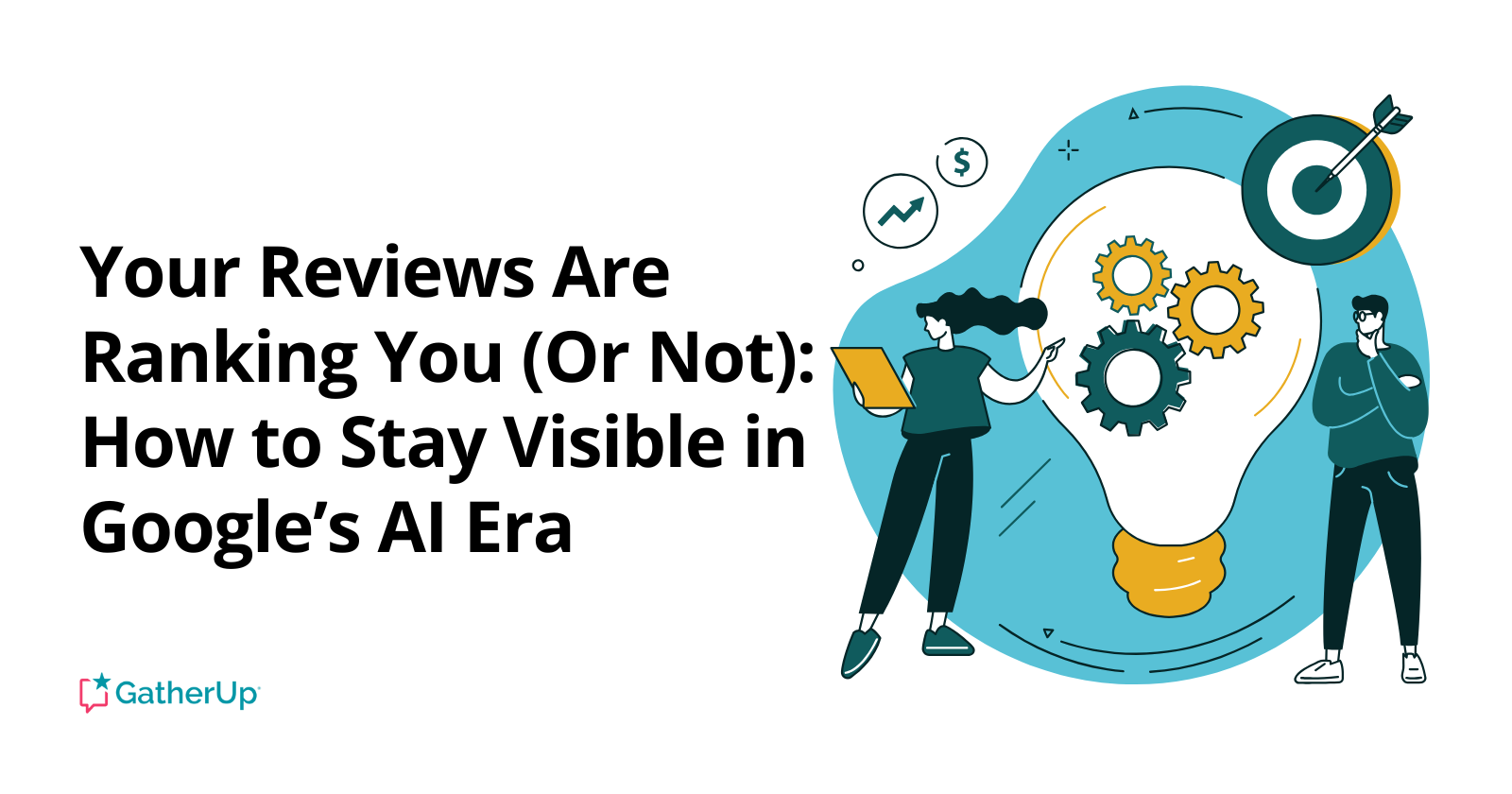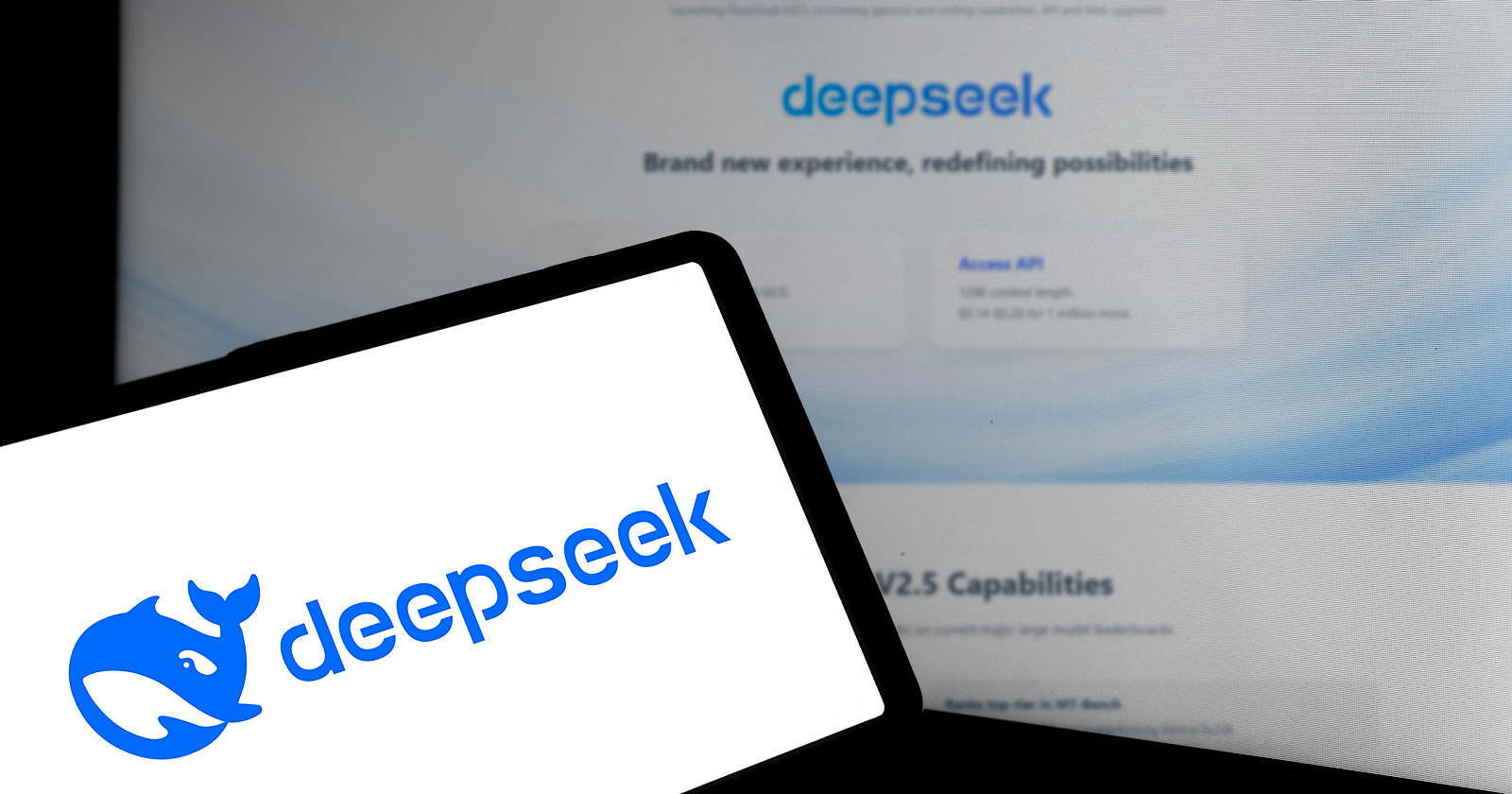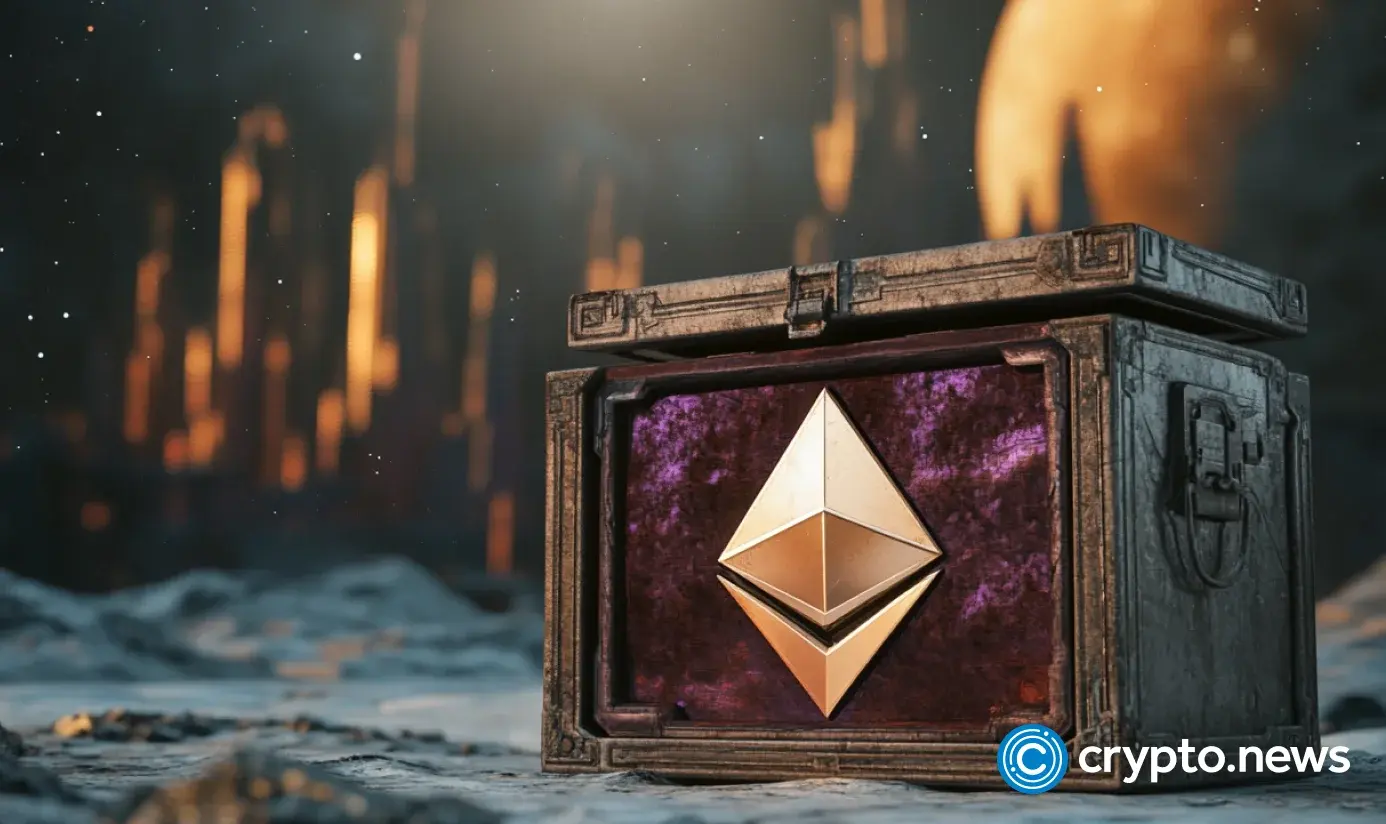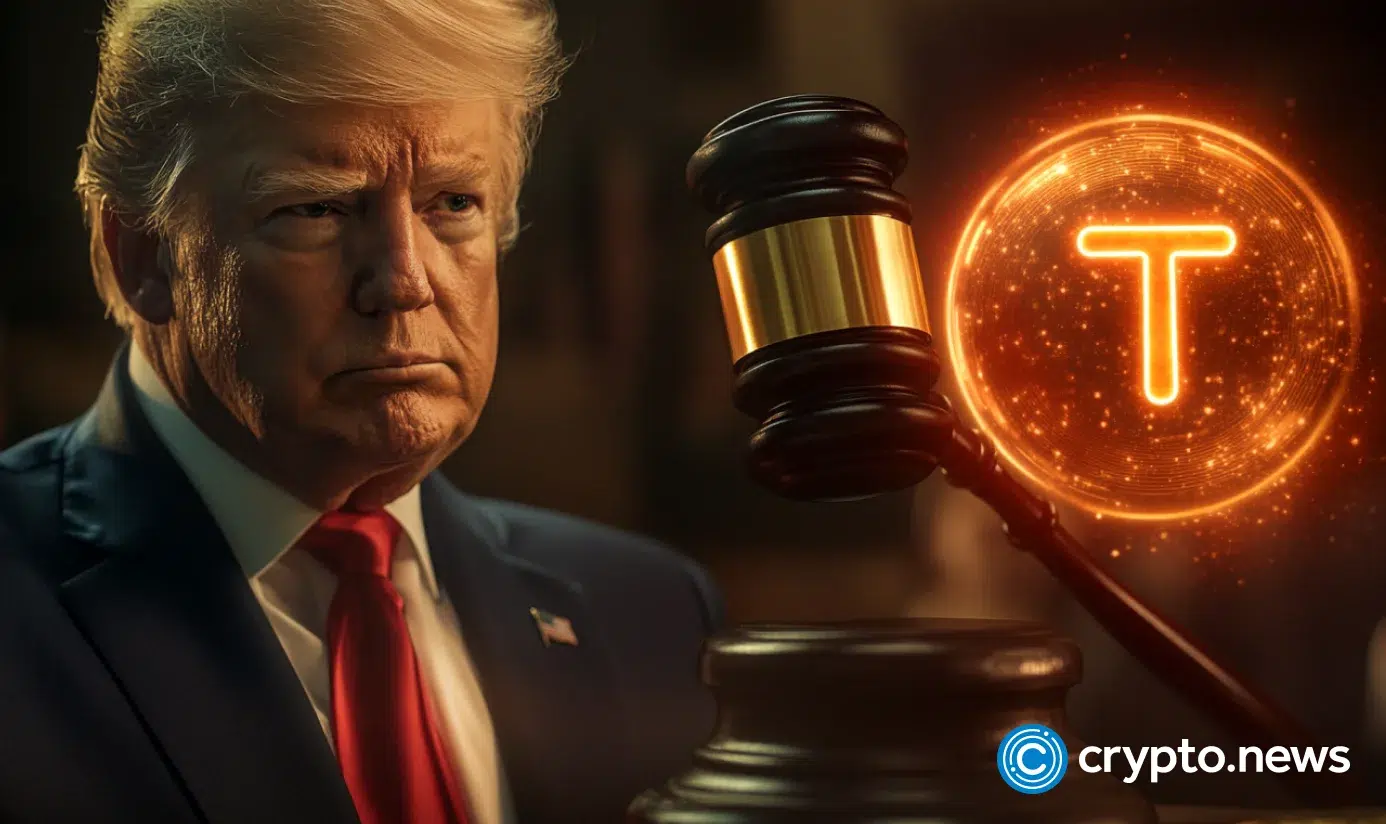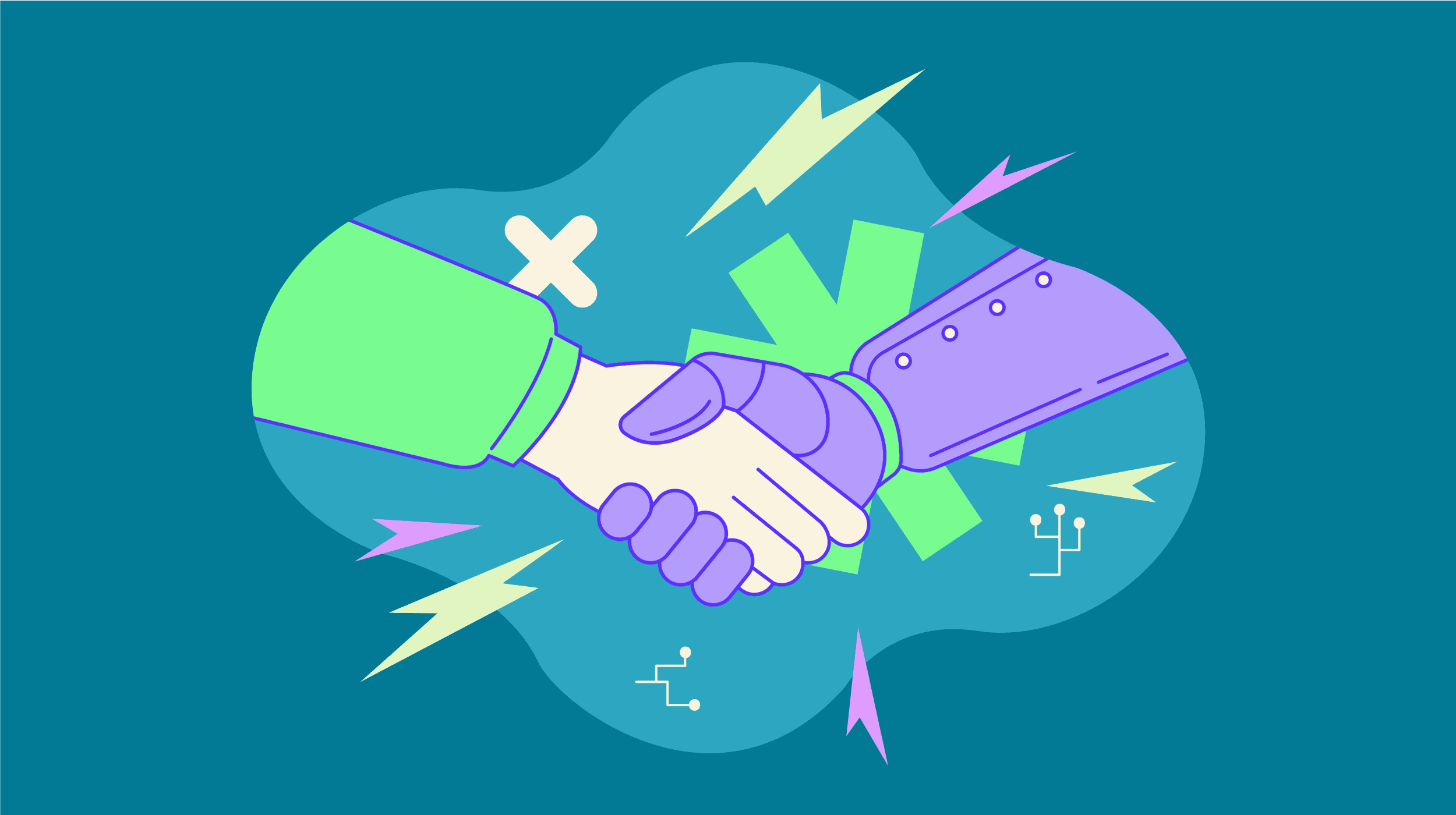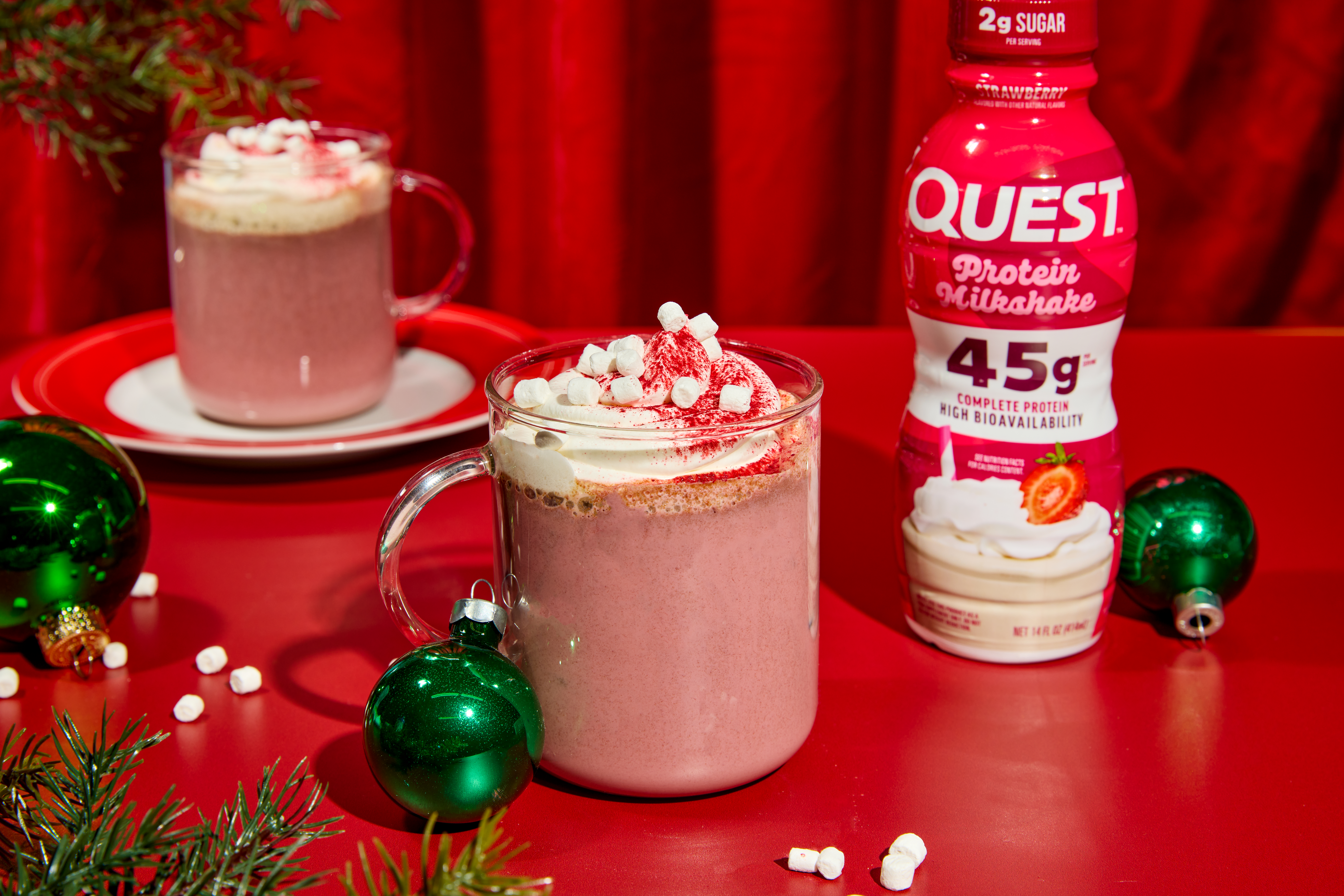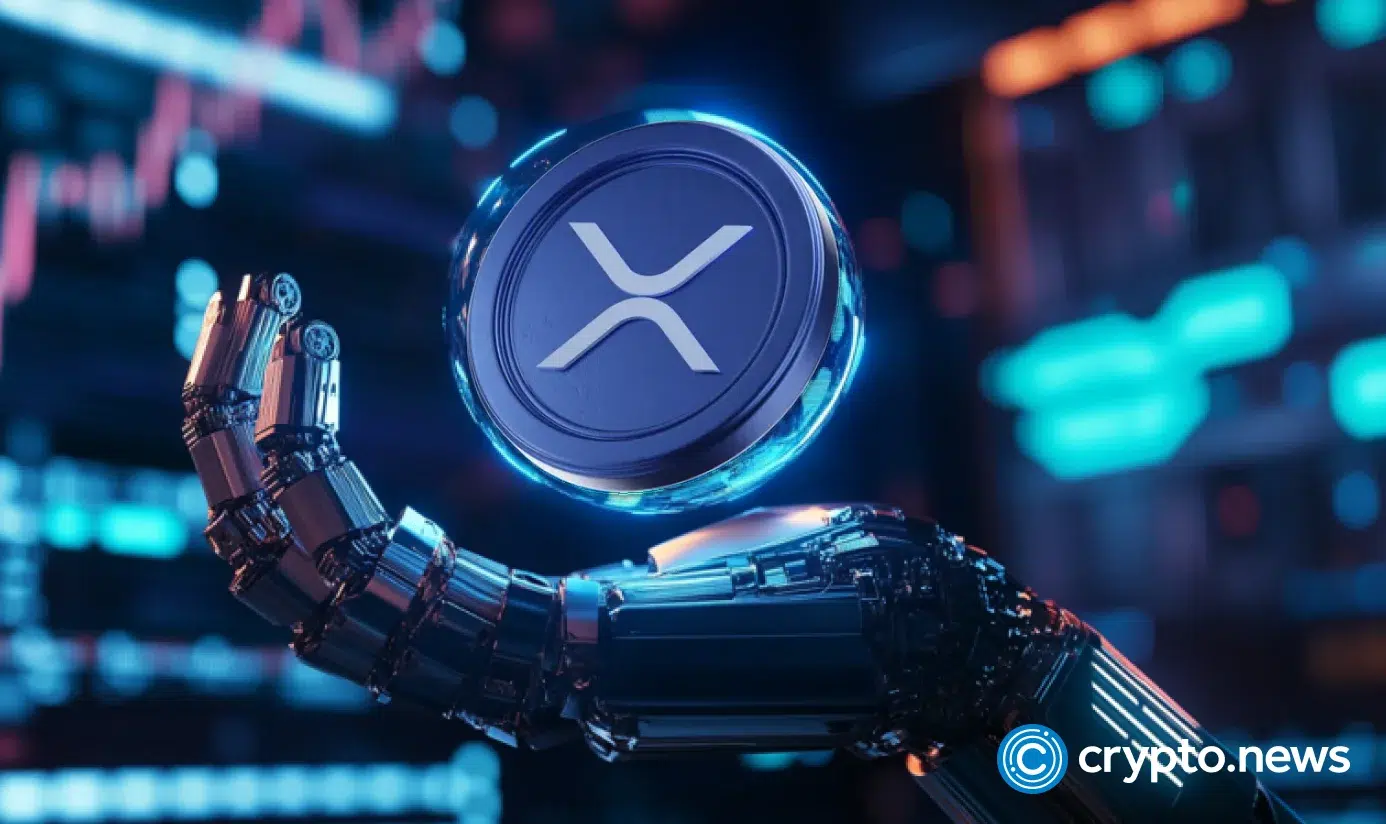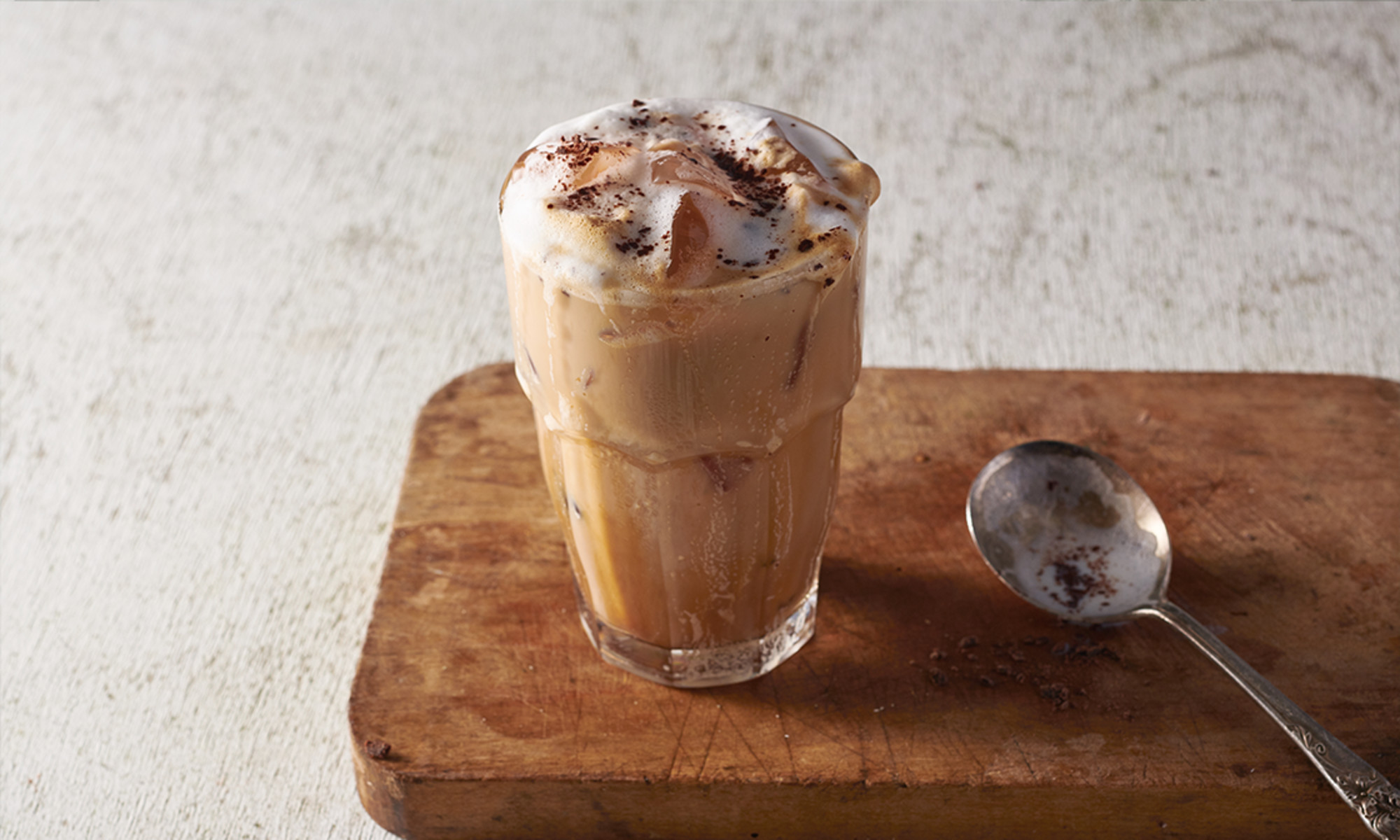What Is Paid Media?
Turning paid ads into profit is a proven path to scalable, predictable growth. When you nail it, paid media gives you a steady stream of customers, without depending on Google’s latest update or social media’s shifting algorithms. In fact,...
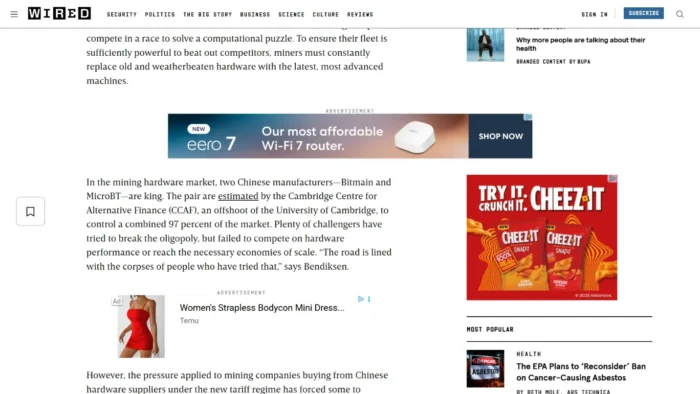
Turning paid ads into profit is a proven path to scalable, predictable growth.
When you nail it, paid media gives you a steady stream of customers, without depending on Google’s latest update or social media’s shifting algorithms. In fact, digital ad spend hit $259B in 2024 and is expected to keep growing.
But which channels are right for you? How can you weave them together into an effective strategy? And what’s the best way to measure your performance?
Here’s what you need to know.
Key Takeaways
Paid media is any form of advertising you pay to place on platforms you don’t own, like Google ads, Facebook posts, banner placements, or influencer partnerships. The big three categories are display ads (banners and videos that stand out), native ads (sponsored posts that blend in), and traditional media (billboards, TV, radio). Search ads and influencer partnerships are the most trusted paid channels because they catch people with intent or leverage existing relationships. A winning campaign has seven steps: get your team aligned, set specific goals, budget for real costs (not just ad spend), know your audience, pick the right channels, create compelling ads, and optimize relentlessly. Track five key metrics: return on ad spend (ROAS), overall return on investment (ROI), cost per click (CPC), impressions, and click-through rate (CTR). These tell you whether you’re making money or just spending it.Paid Media Basics
Paid media is any kind of promotion that meets two criteria: it happens on a platform you don’t own, and you pay for it.
Banner ads are everywhere, like the ones shown in the Wired article below.

Paid media drives real revenue, whether you’re running a startup or managing a global brand.
In research from my team at NP Digital, we found that paid ads make up a meaningful chunk of revenue across businesses of all sizes.

Paid Media vs. Earned Media vs. Owned Media
Think of marketing like a three-legged stool. The three legs here are paid, earned, and owned media.
Understanding how they work and how they work together can help you build a strategy that covers your blind spots and scales over time.
As mentioned earlier, paid media is any promotional placement you pay for. Think search ads, social ads, banner placements, influencer partnerships, and more.
Earned media is unpaid publicity that your business receives from other people and websites. It’s what others say about your brand mentions in news articles, influencer shoutouts, customer reviews, backlinks, or viral social shares.
Owned media is the stuff you fully control. Your website, blogs, social media accounts, newsletters, and email list, fall into this category. You manage the content, the experience, and the message.
Here’s how they fit together:
Paid media helps you get visibility fast, especially when you’re just starting out or entering new markets Owned media builds trust, it’s where your brand message lives Earned media amplifies both. It kicks in when people start talking about what you’re already doing wellThe best campaigns use all three. Paid gets attention. Owned keeps it. Earned multiplies it.
Categories and Examples: Paid Media in the Wild
Paid media is evolving fast. Search, social, video, and display are table stakes, but newer formats are gaining traction too, including ads inside large language models (LLMs) like ChatGPT and Gemini.
Even with all this growth, most formats fall into three core categories: display, native, and traditional. There’s often overlap between them, but these labels help keep things simple.
Display ads: These are visually distinct image, video, and text ads that appear alongside content on the web. Website banners, YouTube ads, and interstitial pop-ups are all examples. Native ads: These are ads that fit within the flow of content and are often indistinguishable from it at first glance. Influencer recommendations, advertorials, and sponsorships are well-known forms of native advertising. Traditional media: Commercials, billboards, and direct mail are examples of traditional media. You don’t get the same tracking or targeting you’d see with digital, but these channels still play a role in large-scale brand awareness.Now that we’ve covered the broad categories, let’s break down some of the most common paid media channels, and where each one fits.
Search Engine Advertising (Search Engine Marketing)
Google, Bing, Yahoo, and even Amazon.
While Google Ads dominates the space, Bing Ads (now part of Microsoft Advertising) can offer lower CPCs (cost per click) and a different audience, especially for B2B brands. Amazon Ads also work well for product-heavy businesses.
We found that search ads across platforms drive some of the highest conversion rates in paid media, second only to channels like LinkedIn and influencer marketing.
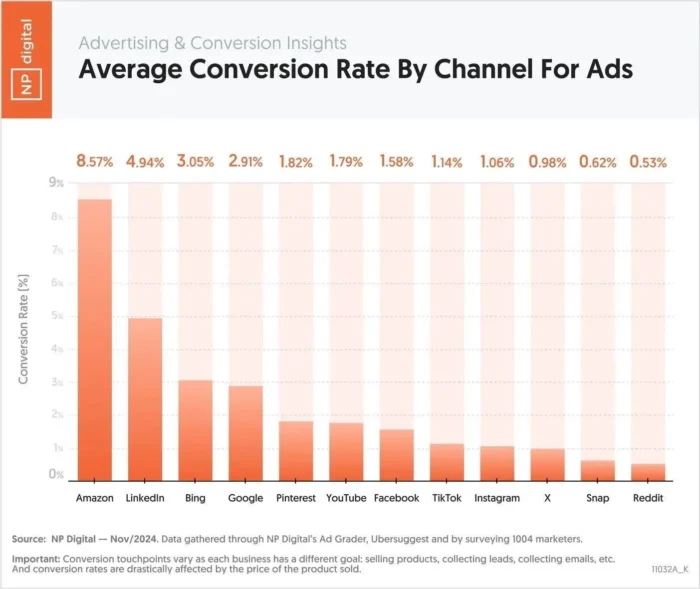
Here’s what the advertising process looks like:
Open an account with the ad network (like Google or Bing) Choose the keywords you want to appear for, such as “gardener in Arizona” Set your maximum bid for those keywords (top bidders appear first) Create your advertisement, which will be text-based Launch your campaign and let Google serve your ad on relevant SERPsThe benefit of SEM is intent. You’re targeting users who are already searching for what you offer, which puts them closer to a buying decision.
And if you’re willing to bid competitively, your ad can appear above the organic result, even above your competitors.
Here’s an example of search engine ads for the keyword “paid media consultant.” Note the “Sponsored” label, which helps users distinguish paid ads from organic results.
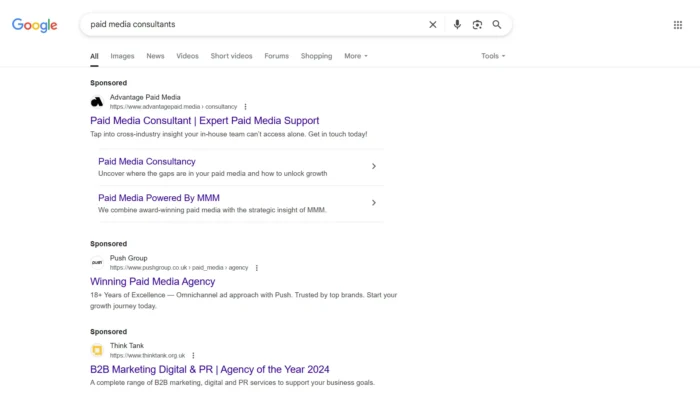
Third-Party Banner Ads
Banner display ads are shown on a third-party online property, usually a website or app.
Most people think banner ads only appear at the top of pages. Not true. Inline banner ads also show in the flow of content. A banner ad is simply a square or rectangular display ad (an ad that is distinct from surrounding content).
NP Digital research shows that banner ads are the least trusted of all paid media formats, underperforming search and influencer ads significantly.
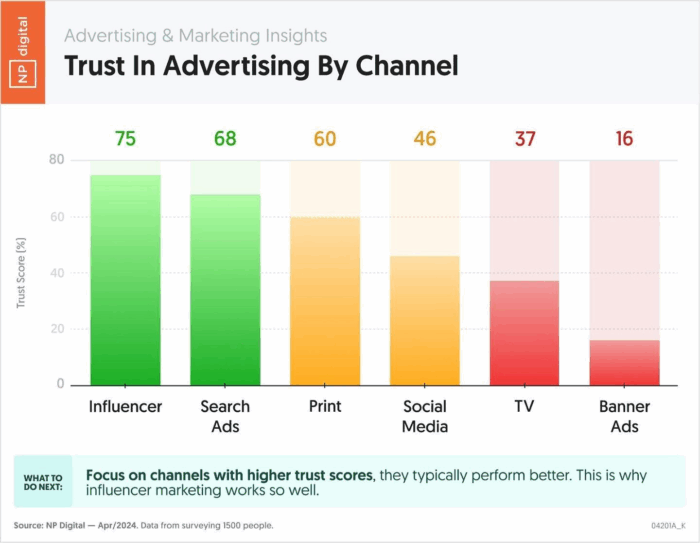
That said, banner ads are good at raising brand awareness. As customers see the same ad repeated across different websites, “brand memory” strengthens. The average person needs to see a brand at least seven times before they make a purchase.
Here’s an example of a fairly conspicuous banner ad on UK news site the Daily Mail:
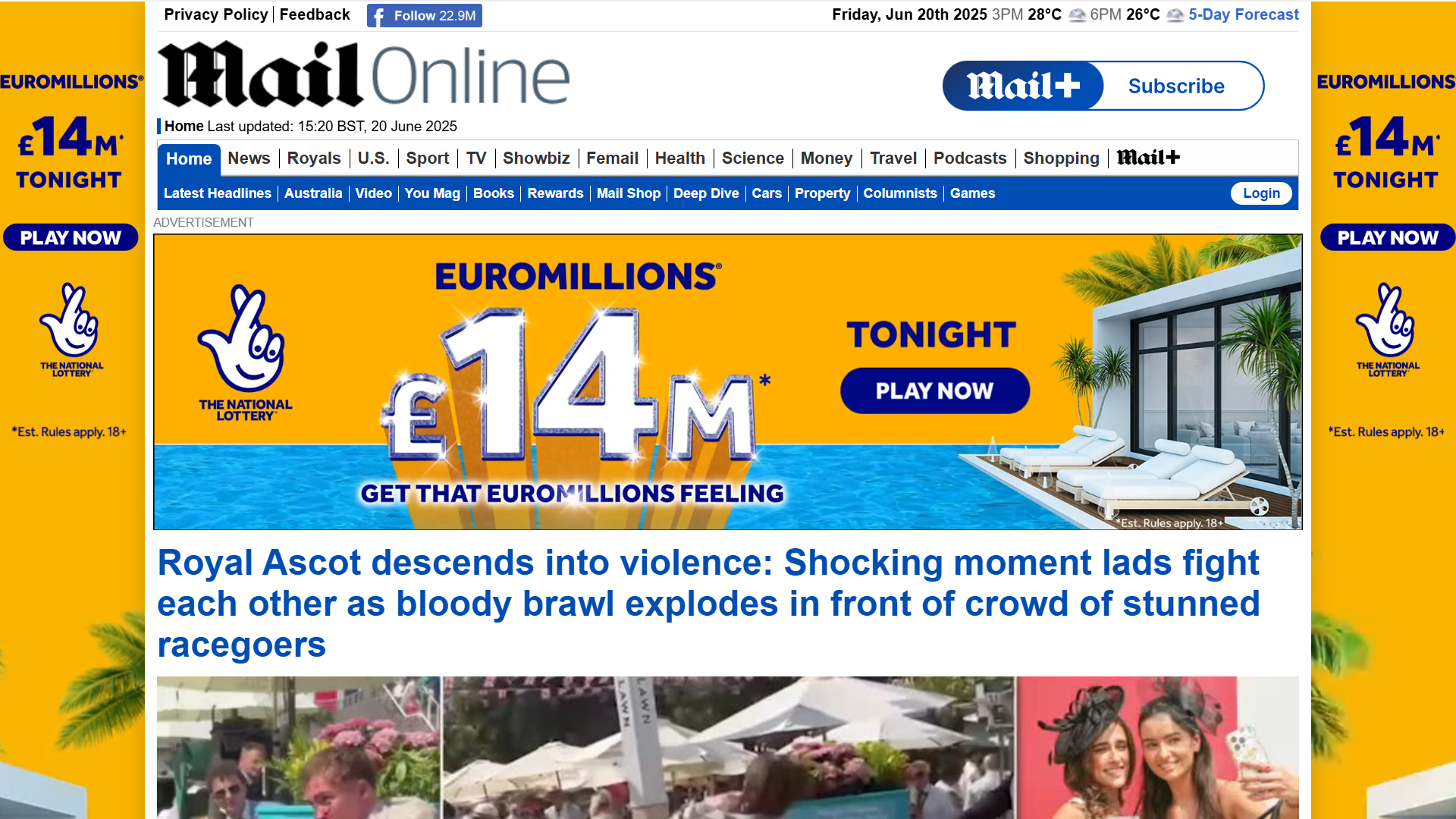
The Google Display Network, the world’s biggest display network, consists of over two million websites and mobile apps that businesses can display their ads on—reaching 90 percent of web users worldwide. When someone clicks on an ad, Google Ads and whoever hosted it share the spoils.
Paid Social Media Advertising
Social media advertising is big business. The global market was worth an impressive $252.95 billion at the end of 2024, and this is set to grow in the future.
According to NP Digital research, Facebook generated over $100 billion in ad revenue last year, making it the top-performing social ad platform. Instagram followed at $70.9 billion.
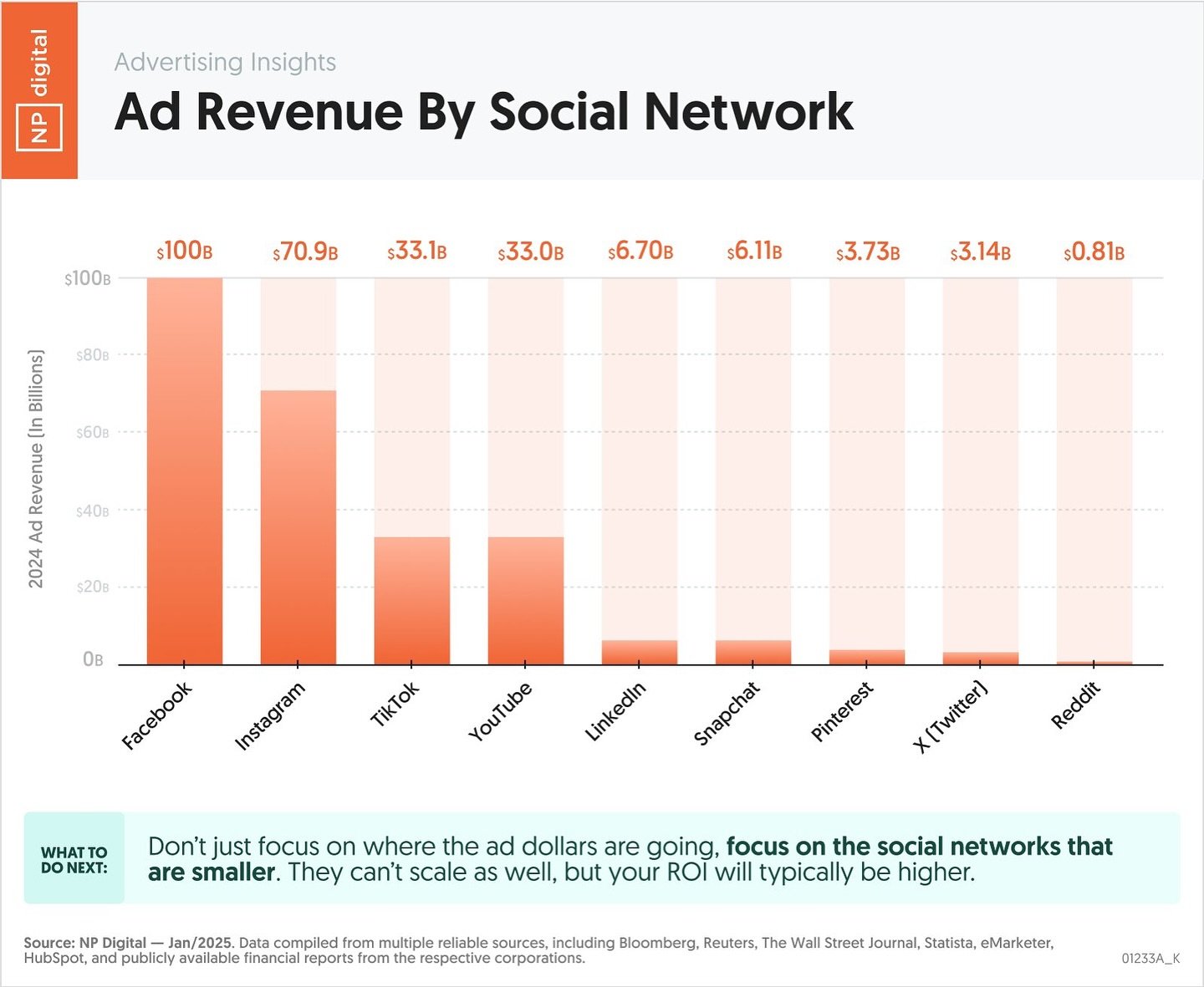
Here’s an example of paid media advertising on Facebook. This sponsored post is by McDonald’s and appears in relevant customers’ newsfeeds, enticing them to try their $8 Chicken McNugget Meal. These ads blend into the feed but still offer clear calls to action.
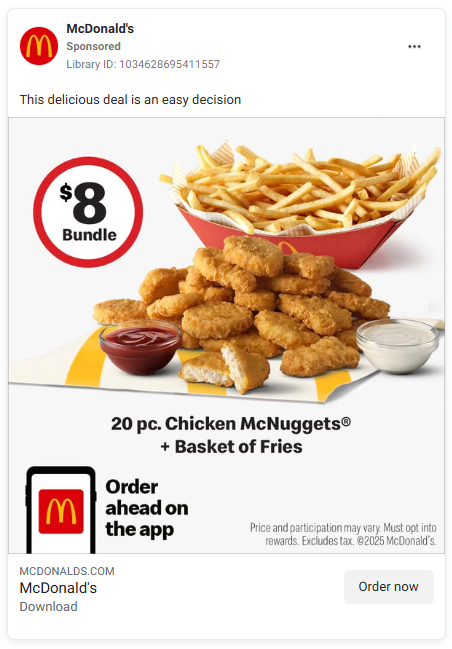
And it’s not just for B2C. In the LinkedIn ad below, Microsoft targets professionals in banking with an ebook download offer.
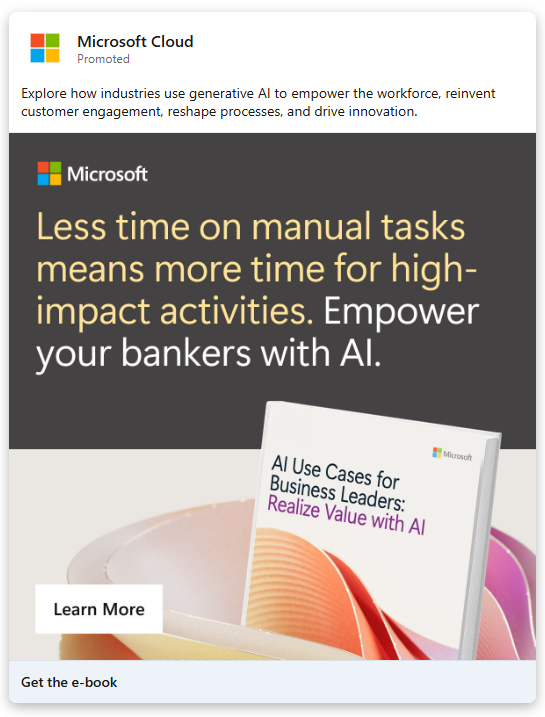
Social ads work because they meet people where they’re already scrolling. Nearly 60 percent of the world’s population has at least one social media account.
Even better, social platforms give you advanced targeting tools. Most platforms let you target people by age, gender, and location, as well as their hobbies and other social media accounts they follow.
Video Advertising
Video content gets more engagement than static text or images. In fact, one NP Digital study found that short-form and long-form videos accounted for 31.38% and 15.51% of all engagement, respectively.
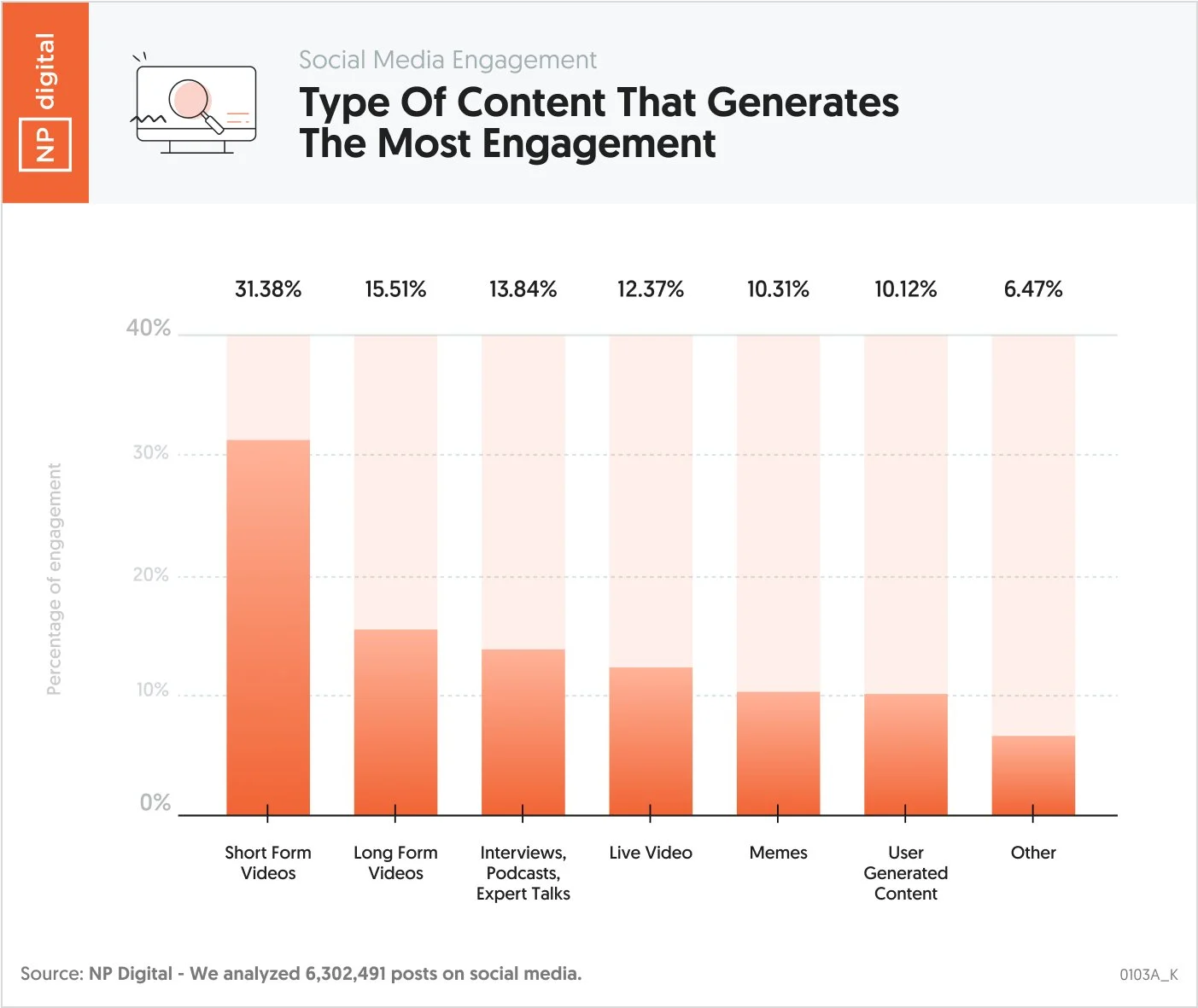
That kind of engagement makes video a powerful paid media tool, especially on platforms like YouTube, Facebook, TikTok, and Instagram.
Video ads show up before or during content users are already watching.
What makes video ads effective is how they combine storytelling with visual cues. Create a stylish, funny, or cool video, and people will naturally want to discover your brand. Like display ads, videos are great for capturing people’s attention on mobile as well.
In-App Ads
In-app ads are paid placements that show up inside mobile apps while someone is using them. These can be banner ads, video ads, interstitials (full-screen takeovers), or rewarded ads where users watch a video in exchange for in-app perks.
You’ve probably seen these in gaming apps, news apps, or streaming services. They appear between levels, in feed scrolls, or before content loads.
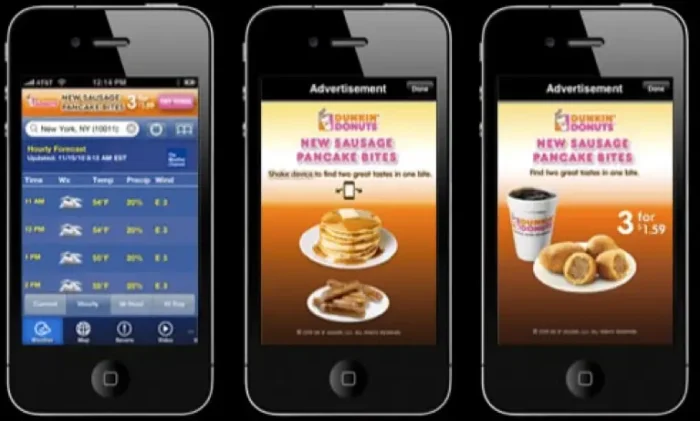
These ads work well if your audience spends a lot of time on mobile, and even better if you’re targeting users by behavior, interest, or location. App data gives you targeting options you won’t always get on the open web.
Performance varies by industry, but in-app ads tend to perform best for consumer apps, entertainment, retail, and local services.
Digital Out of Home (DOOH) Ads
DOOH ads are digital billboards, transit screens, and signage in public spaces. You’ve seen them in malls, airports, gas stations, elevators, and even gym treadmills.
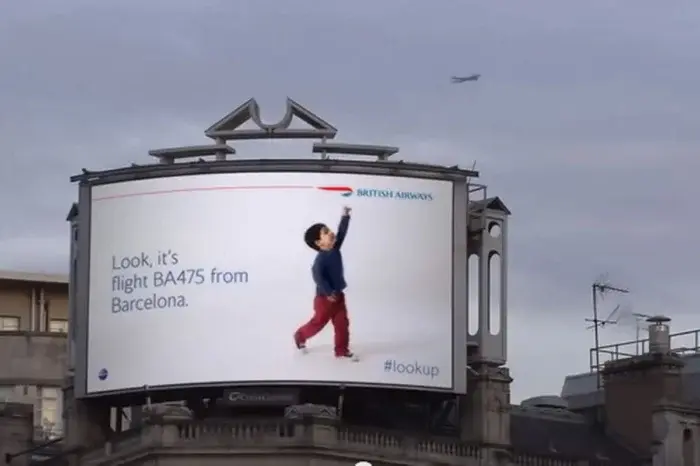
Source: BMedia Group
Unlike traditional out-of-home ads, these use screens and software, which means you can update them in real time and target by location, time of day, or audience segment.
They’re a great fit for local campaigns, brand awareness pushes, or national advertisers who want visibility in high-traffic areas. You won’t get click data, but they can be effective for driving searches, visits, and offline conversions.
DOOH is especially useful when paired with mobile or geotargeted campaigns. Seeing a screen ad in a gym, then getting a related offer on your phone, is the kind of multi-touch experience that performs well.
Connected TV (CTV) and Over-the-Top (OTT) Advertising
Connected TV (CTV) and Over-the-Top (OTT) ads show up inside streaming content, on platforms like Hulu, Roku, YouTube TV, and Peacock. These are the ads you see while watching shows or movies on smart TVs, streaming boxes, or even mobile apps.
The big difference? CTV runs on television screens. OTT can run on any device.
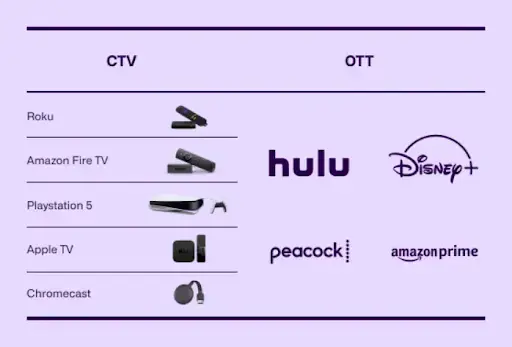
Source: Madhive
These ad formats are great for reaching cord-cutters who’ve moved away from traditional cable. They’re also more trackable than old-school TV ads, with options for targeting by location, device, behavior, and even interests.
CTV and OTT ads are especially useful for brand awareness, product launches, and retargeting. You can run short video ads in high-attention environments—and often get better completion rates than on social.
Large Language Model (LLM) Ads
LLM ads are an emerging format of paid placements that appear in large language model tools like ChatGPT, Google Gemini, and Perplexity. These ad types are still in the early stages, but they’re gaining momentum as AI assistants become part of everyday search behavior.
Right now, some platforms are testing sponsored response blocks or product carousels within AI-generated answers. These typically appear when users ask for recommendations, product ideas, or service comparisons.
For marketers, LLM ads offer a new way to show up during early-stage research, especially in verticals like travel, consumer products, software, and education.
Unlike traditional search ads, these placements are more dependent on content quality and relevance than keyword bidding. That gives brands with helpful, trustworthy content an advantage.
This space is still evolving, but it’s one marketers should keep a close eye on. Testing early gives you a head start as AI search platforms build out their ad offerings.
Sponsorships and Advertorials
Sponsorships, advertorials (paid articles), and influencer marketing are the most prominent examples of paid native advertising.
These ads blend in with regular content.
Here’s an example: an article written by a company executive who’s part of Forbes Council, a paid program that entitles members to publish a set number of articles every year. It looks like editorial content, but it’s paid for, and the author gets guaranteed publishing rights.

Sponsored posts are everywhere, especially on social. The Instagram post below is clearly labeled as a “Paid partnership with Gymshark.” This post feels authentic because it comes from a trusted influencer, not a brand’s ad account.
Along with that, since the influencer has a loyal, engaged following—the post has over 140,000 likes—the ROI will likely be positive for the advertiser.

What makes these work? Trust. When the message comes from someone users already trust, it tends to land better, and perform better.
Benefits of Paid Media as a Marketing Channel
Here are some key benefits of paid media for marketers:
You have more control. As you pay to advertise, you get more say over your ad’s appearance. Conversely, if you submit a press release to a publication, they may edit it to suit their in-house tone of voice. You get immediate visibility. Search engine optimization (SEO) costs less than paid media, but it can take three to 12 months to see optimal results. With paid media, if you’re happy to pay, you can appear in front of prospective customers immediately. You can measure results. Paid ads platforms offer detailed analytics so you can see how your ads are doing. Some even provide a quality score so you know which campaigns you need to optimize. You can tailor your ads. You can target your ads to specific groups of customers and even tailor content toward a location. This increases the chances of people responding positively to your advertisements. Similarly, you can advise who you don’t want your ad to show to. You can implement automation. You can be as hands-on or hands-off with your advertising as you want. For example, Google Ads offers automated bidding where it automatically optimizes your bids to appeal to people more likely to help you achieve your goals.Top 5 Paid Media Metrics for Paid Media
You could track dozens of metrics, but these five matter most.
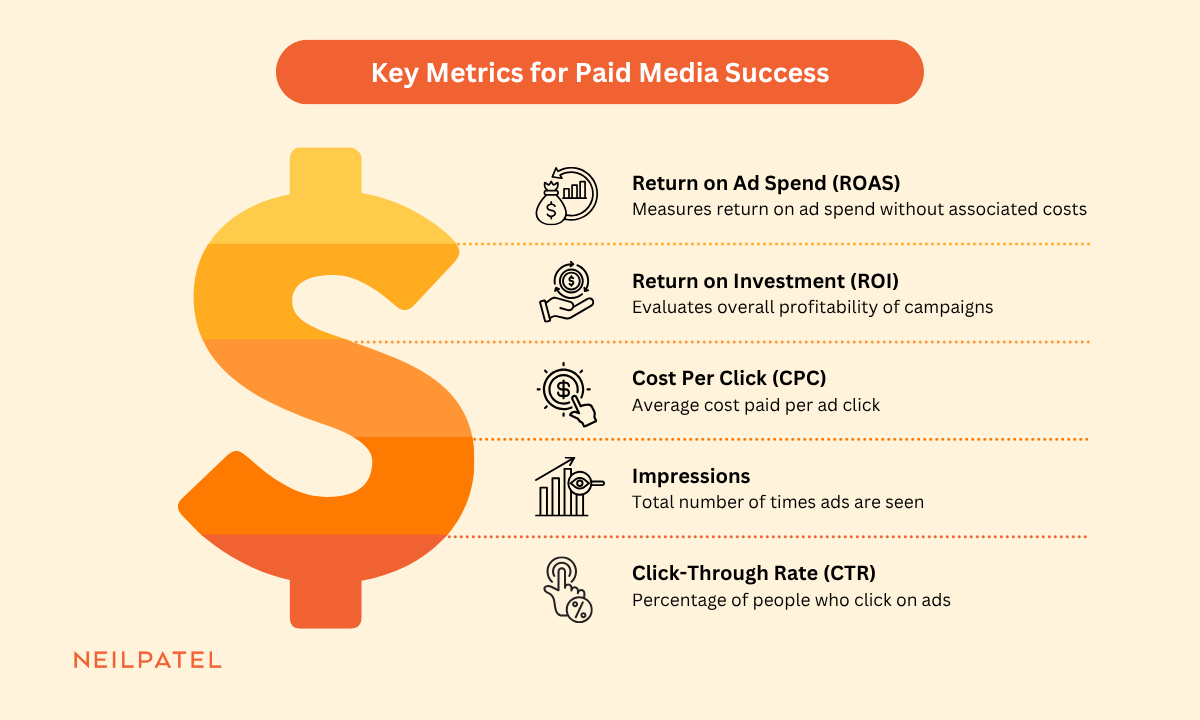
There are lots of metrics you can use to track the success of your paid media campaigns. The risk is that you get lost in a sea of data.
I recommend a simplified approach. One that lets you hone in on channels with potential, drop those that aren’t working, and demonstrate a clear ROI throughout.
Here are my top five metrics for paid media:
These give you a clear picture of performance and help you decide where to optimize or pull back.
Return on ad spend (ROAS): ROAS tells you how much revenue you’re generating for every dollar spent on ads. It’s important to measure this separately because it’s the first thing you need to remedy if you’re not achieving a positive ROI overall. If your ROAS drops, you may need to adjust your targeting, creative, or offers. Return on investment (ROI): This is the big one. If you’re generating more from your paid media campaigns than it costs to run them, you’re on the right track. Account for everything—creative costs, time managing ad accounts, A/B testing, etc.—and not just the ad platform fees. Paid media without ROI is just spend. Use this number to decide whether to scale or pause. Cost per click (CPC): This is the average amount you pay whenever someone clicks on your ad. Ideally, this should be as low as possible. It’s a ripe area for optimization. CPC is most useful when viewed alongside CTR and conversion rate. A low CPC doesn’t help if nobody converts. Impressions: This is the total number of times users see your ads. A high reach shows that you’ve chosen a channel that gives you exposure to a large audience, which is important for brand building. Low impression count? It might be time to evaluate the reach of your chosen channel. Impressions alone won’t drive results but they show whether your ads are getting visibility in the first place. Click-through rate (CTR): This is the percentage of people who see and click on your ad. A high CTR shows that people find your ad interesting and valuable.How to Create a High-ROI Paid Media Campaign: 7 Steps
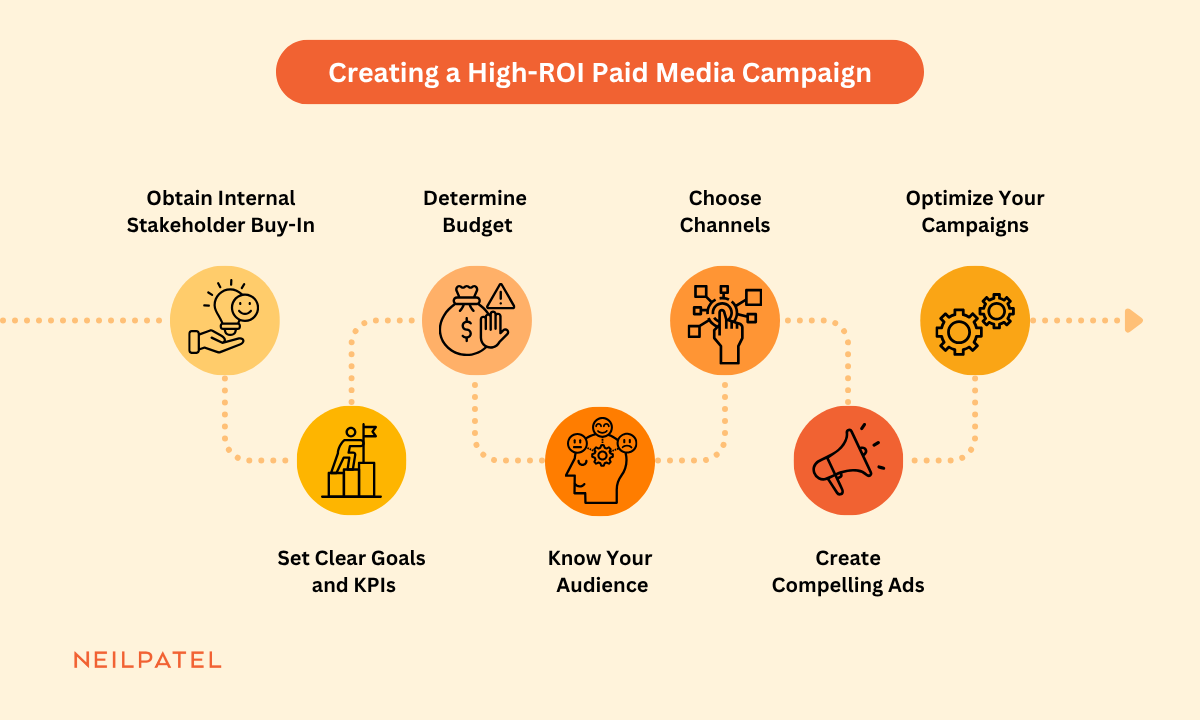
Paid media can generate traffic, leads, and revenue, but only if you approach it with a clear plan. Skipping strategy and jumping into ad spend is one of the fastest ways to burn through your budget.
Because large amounts of money are involved, caution is your ally. Many businesses burn through cash before giving up on paid media, wondering what went wrong.
Your paid media strategy should clearly cover the following:
Which internal stakeholders you need to include Goals you want to achieve Characteristics of your audience Platform-specific budgets Viable paid media channels Products and services you want to promote Metrics for gauging successThe process doesn’t need to be complicated. These seven steps will help you build a campaign that’s focused, efficient, and ready to scale.
1. Obtain Internal Stakeholder Buy-In
Getting buy-in goes beyond simple approval. Your team needs to fully understand what’s happening, why it matters, and what role they play.
Start by identifying who needs to be involved. At a minimum, that usually includes:
Marketing leadership (budget, goals, channel mix) Creative teams (ad copy, assets, landing pages) Analytics (conversion tracking, attribution setup) Sales (if the campaign impacts lead gen or pipeline)Don’t wait until after launch to bring these teams in. Paid media works best when everyone is aligned from day one.
Set up a short kickoff meeting to walk through the campaign plan. Cover what you’re promoting, who you’re targeting, what platforms you’re using, and how results will be reported.
It doesn’t have to be a big formal process. A shared doc, quick sync, or even a Slack thread can go a long way.
The goal is to eliminate surprises and make it easy for other teams to support the strategy.
2. Set clear goals and KPIs
You need to know exactly what you’re trying to accomplish. Metrics are important (we’ll come to those later), but goals lay the foundation.
If you don’t know what success looks like, it’s easy to waste money. That’s why clear goals are the first thing to lock in, before budgets, platforms, or creatives.
Start by asking one question: What do you need this campaign to accomplish?
This could include:
Lead generation Product sales Free trial signups App installs Event registrations Traffic to a specific landing page Brand awareness in a new marketBe specific, not general. “More leads” isn’t a goal. “Generate 250 demo requests this quarter at a CPL (cost per lead) under $80” is. Pass your goals through the SMART test: are they Specific, Measurable, Attainable, Relevant, and Timely? The more detailed you make the goals, the easier they will be to achieve.
After that, you can pick KPIs and metrics that match your objective, which we will be talking about in a little bit.
3. Determine budget
With paid media campaigns, it’s essential to set a budget and stick to it. Many paid media platforms let you set a definite upper limit for your ad campaigns. If you exceed this budget, the platform stops showing your ads.
Your budget isn’t just ad spend, but it fuels the entire campaign. Along with the baseline budget for your paid media ads, you must also consider additional costs. These include ad copywriting, graphic design, and videography. If you use an agency, you’ll have to cover ongoing account management fees.
Start by figuring out what success looks like. If your goal is to get 100 leads at $50 each, you’ll need to spend at least $5,000 in ad budget alone. That’s your baseline.
Then add in the supporting costs:
Ad creative (copy, graphics, video, landing pages) Tracking and analytics setup A/B testing budget to compare variants Management costs if you’re outsourcing or using toolsDifferent platforms also have different minimums and cost expectations. Running paid social on Facebook or Instagram can be more flexible for smaller budgets. Search ads on Google or Bing often require more competitive bidding to see traction.
Don’t spread your budget too thin. It’s better to run fewer campaigns with enough spend to test and optimize properly, instead of trying to be everywhere with limited reach.
And whatever number you start with, keep a reserve. Paid campaigns almost always need tweaking in the first few weeks.
4. Know Your Audience
The more specific you get with your targeting, the less you waste on clicks that go nowhere. If you’re paying for media on a publication or newsletter, you can compare your ideal customer profile (ICP) to the audience specs.
Research all the following points for your ICP:
Here’s how your audience research translates into paid media results:
Ad platforms: Choose based on where your audience actually spends time Creative: Match tone, visuals, and messaging to their mindset Offers: Promote what solves their problem, not what you want to sell Targeting settings: Use demographics, behaviors, and interests to narrow reach Retargeting: Build separate campaigns for cold traffic vs. returning visitorsThe goal is to reach the right people at the right stage and give them a reason to click.
5. Choose Channels
Not every platform fits every goal. The right channel depends on who you’re targeting, what you’re promoting, and how fast you need results.
Take the following into consideration when choosing where to advertise:
You can also learn a lot by seeing where your competitors are advertising. Tools like Meta Ad Library, Google Ads Transparency Center, and manual Google searches will show you what channels they’re using and how often they show up. Look at their messaging, creative, and landing pages. If it’s working for them, it might work for you.
Budget matters, too. Some platforms are better suited to lower ad spend. Facebook, Instagram, and TikTok can give you meaningful reach on a modest budget. Search or YouTube may require more competitive bidding to see real traction.
For smaller budgets, focus on one or two channels where your audience is most active. Don’t try to be everywhere if you can’t afford to run meaningful tests.
And don’t lock yourself into one format. The best campaigns evolve. Start with the highest-potential channel, then expand once you’re confident in performance.
6. Create Compelling Creative
Here are some of my top tips for designing paid media ads that drive clicks:
Don’t be afraid of being “loud”—you want an ad that customers stop and look at. Keep your ad copy clear and concise. User-generated content and testimonials show prospects why existing customers love your brand. If you’re using search advertising like Google Ads, take advantage of assets that tell customers more about your business for no additional cost. Run multiple variants of your ads from the get-go for some quick A/B test wins.But good creative is more than just how your ad looks, it also covers what you say and how fast you get to the point. Lead with the benefit, keep the message tight, and match your CTA to the user’s intent.
Make sure your offer matches the awareness stage also. A discount works well for bottom-of-funnel buyers. But for top-of-funnel, try a quiz, guide, or video to build interest first.
Finally, try to avoid launching with just one ad. Rotate in multiple headlines, formats, and visuals early so you can learn what actually converts before you scale spend.
In addition, some paid media platforms have ad libraries where you can see examples of paid media ads from your competitors. Meta (Facebook and Instagram), TikTok, LinkedIn, and Google Ads all have libraries. They’re fantastic sources of inspiration.
7. Optimize Your Campaigns
Like all digital marketing campaigns, paid media is not something you can set and forget. When it comes to optimization, little and often wins the race.
I recommend checking your paid media accounts at least once a week, even once a day if you’re running a short-term campaign.
Paid media is excellent for running multivariate and A/B testing. You can create multiple ad versions with small differences—such as CTA texts or color schemes—and test them against statistically significant sample sizes.
But don’t stop at testing creative. Optimization includes your audiences, bidding strategy, landing pages, placements, and even campaign structure.
Here’s what to review regularly:
Which ads are getting clicks but not conversions? Pause or adjust those. Which campaigns are spending without results? Reallocate that budget. Are certain audiences or geos outperforming others? Double down where it counts. Is your cost per result trending up or down? That’s your early warning system.Document what you’re testing and why. Optimization doesn’t mean quickly reacting without thinking. Your team needs to learn over time and building a smarter strategy with every round.
Paid Media and AI: Trends You Need to Know
AI is already shaping how campaigns are built, optimized, and scaled. My team and I ran research looking at AI vs. human-generated ads, for example, and found that AI ads converted at 1.28%, less than half a percentage point below human ads, which converted at 1.54%. Yes, human ads performed better. But not by a huge margin.
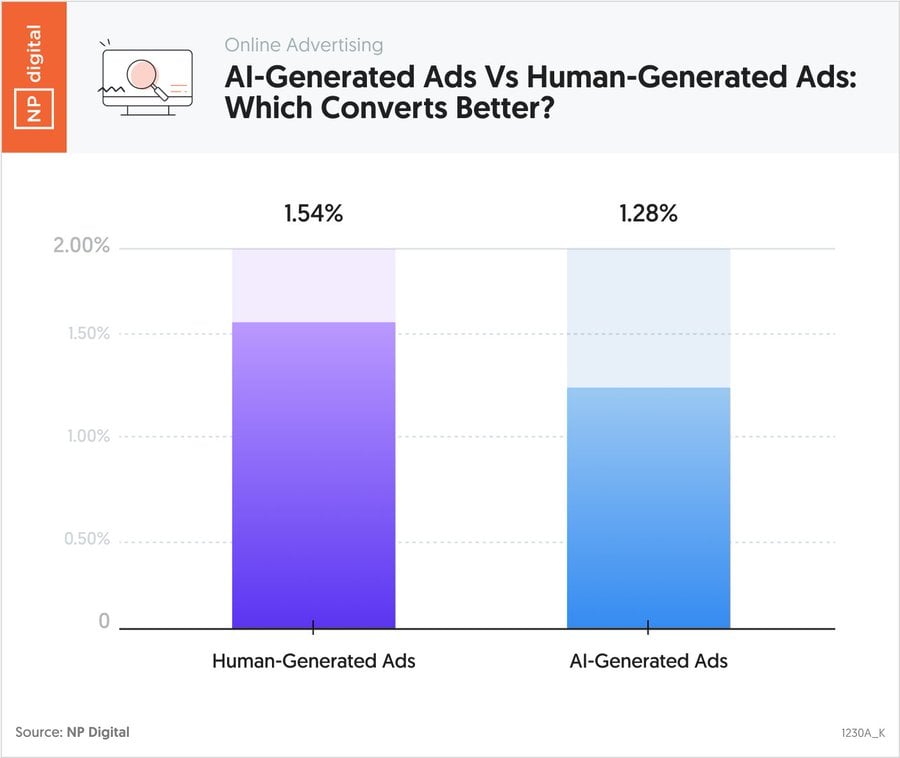
I would urge digital marketers to keep the following four points in mind when it comes There are already a growing amount of applications for AI in the world of paid media:
Marketers are using AI to:
Write ad copy faster (especially for high-volume campaigns) Build and test ad creative using AI image and video tools Generate audiences automatically based on existing customer data Optimize budgets in real time across channels Predict what offers or creatives will perform best, before spending anythingThese aren’t experimental use cases anymore. They’re being built directly into the tools marketers already use.But things are changing fast. Here’s some key points to keep in mind:
Paid media isn’t going anywhere: Most paid media channels will remain viable. People will continue to read their favorite publications, open newsletters, follow influencers on social media, listen to podcasts, and so on. Even if traditional SEO and search ads vanish, LLMs like ChatGPT will need to monetize at some point. Revenue from ads provides stability: As AI changes the way people consume content online, revenue from ads can actually provide more stability. Unlike organic traffic, they’re not dependent on algorithms over which you have no control. Paid media helps you build brand citations: Branding will be more important than ever in the age of AI. Citations around the web are one of the ways LLMs identify and measure the relevance of your business to a particular query. For example, if “NP Digital” appears often in AI training materials next to “advertising agency,” my brand is more likely to be referenced in response to related questions. Now is the time to start experimenting with AI: As was shown in the research by me and my team, AI can perform nearly as well as humans. For a head start when AI is truly ready to assist with paid media campaigns, you should start experimenting and learning now. That said, AI is a tool, not a strategy. You still need strong positioning, good creative, and clear goals. But if you’re not testing AI workflows now, you’re going to fall behind the brands that are.Should You Focus on One or All Channels?
Most marketers think they need to be everywhere. That’s usually wrong.
To be clear, I’m a big proponent of omnichannel digital marketing.
When you’re everywhere, you reach more of your prospects. Yet you would be amazed at how many businesses fail to grasp this simple fact.
With that said, for paid, omnichannel may sound great, but isn’t always the right move.
With large amounts of money at risk, you need to do two things: research and test.
If you’re just getting started with paid media, stick to one or two platforms where your audience is most active. That gives you enough budget and data to learn what works without spreading yourself too thin.
Once you’ve found a winning message and offer, then it makes sense to expand. You can start repurposing creative, retargeting across platforms, and building a true full-funnel system.
Here’s the truth: omnichannel paid marketing only works when you have the team, budget, and systems to support it. Otherwise, it turns into a mess of disconnected campaigns.
Ask yourself:
Do you have the creative capacity to build for multiple formats? Do you have enough budget to collect meaningful data across platforms? Can you track performance in a way that ties everything together?If the answer is yes, go for it. If not, focus and scale intentionally. The best paid media campaigns start small, then scale up.
FAQs
What is paid media?
Paid media refers to any marketing or advertising content a brand pays to place on a third-party platform. Common examples include search engine ads, social media ads, display banners, video ads, influencer sponsorships, and traditional placements like radio, print, or TV.
The key benefit of paid media is the ability to generate visibility and traffic quickly, often with precise targeting and measurable results. Brands typically use paid media to reach new audiences, promote offers, or support other marketing efforts. It works best when paired with earned and owned media in a broader strategy.
How often should you evaluate your paid media budget?
Most brands should evaluate their paid media budget weekly. This allows time to monitor spend, performance, and early signals on what’s working.
For short-term or high-investment campaigns, daily budget checks are recommended to catch issues before they impact results.
Monthly or quarterly reviews are useful for larger budget adjustments, channel planning, or reallocation based on return.
Consistent monitoring ensures your budget is supporting your goals and allows for real-time optimizations, rather than reactive fixes after performance dips.
How do you build a paid media strategy?
A strong paid media strategy starts with setting a clear objective, such as lead generation, product sales, or brand awareness.
From there, define your target audience and select platforms that align with where they spend time. Creative should match the platform and campaign goal, while KPIs like ROAS, CPC, or conversion rate help track progress.
Budget should be allocated based on priorities and expected return, with room for testing.
Successful strategies are built on iteration—launching, analyzing, and optimizing based on what the data shows.
What’s the difference between earned media and paid media?
Paid media includes advertising you pay for, such as social ads, search ads, sponsored content, and display banners. It gives you control over placement, timing, and messaging.
Earned media refers to organic exposure you don’t pay for—such as press coverage, backlinks, user reviews, or social shares.
While paid media drives immediate visibility, earned media builds trust and long-term authority. Most marketing strategies benefit from a mix of both, with paid media often used to accelerate early reach.
Conclusion
Most marketers treat paid media like throwing money at a wall and hoping something sticks. That’s expensive and frustrating.
The brands winning with paid media treat it like a system. They start with one platform, nail their message and targeting, then scale what works. They track the right metrics, test relentlessly, and aren’t afraid to kill campaigns that aren’t delivering.
If you’re just getting started, pick Google Ads or Facebook—whichever platform your audience uses most. Set a budget you can afford to lose while you learn. Create multiple ad variants from day one so you can see what resonates.
Want to see what’s coming next? Check out the latest paid media trends shaping the industry.
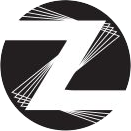
 Konoly
Konoly 








